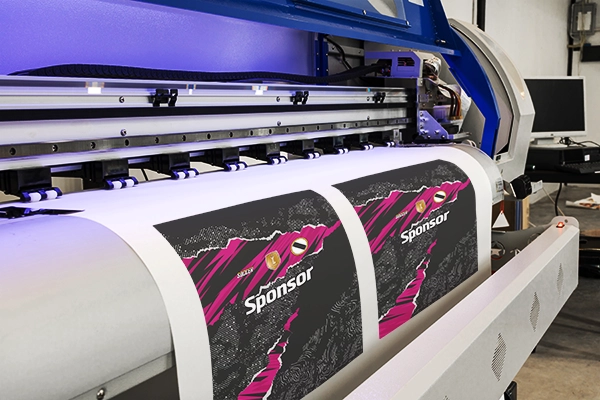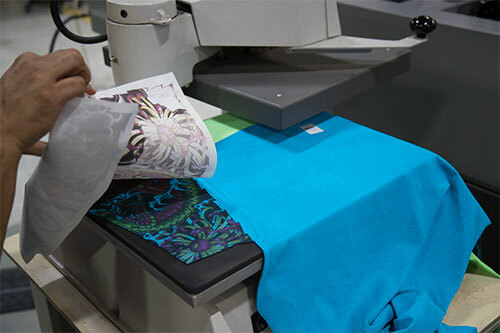Why DTF Printing is the Future of Customized Garments Manufacturing
Why DTF Printing is the Future of Customized Garments Manufacturing
Blog Article
A Comprehensive Overview to the Different Kinds Of Towel Printing Techniques
Starting an exploration of towel printing methods discloses a fascinating crossway of practice and development. Each technique, from the meticulous craftsmanship of block printing to the quick efficiency of display printing, serves one-of-a-kind purposes and provides unique advantages. Digital printing's versatility and ecological consciousness stand in stark comparison to the quick customization of warm transfer printing. Dye sublimation printing captivates with its capability to generate dynamic, long-lasting layouts on artificial textiles. To truly understand the subtleties and prospective applications of these diverse methods, a deeper investigation is crucial.
Block Printing
Block Printing, one of the earliest approaches of textile decoration, has a rich history that goes back to old human beings. Stemming in China around 220 A.D., this technique later spread out to India and at some point Europe. The procedure includes carving intricate designs right into wood blocks, which are then dipped in dye and pushed onto material to produce patterns. This method is notable for its ability to generate extremely detailed and repetitive layouts.
The precision and workmanship associated with block printing make it a labor-intensive process, however it also enables a high level of customization. Craftsmens can produce unique patterns by incorporating different blocks or differing the application of dye. This flexibility has actually contributed to the long-lasting popularity of block printing in both modern and conventional fabric style.
Block printing is specifically valued for its aesthetic top qualities, including the mild variations in pattern and shade that result from the hand-printing process. These blemishes provide an unique personality to each piece, identifying it from mass-produced materials. Regardless of advancements in modern-day printing innovations, obstruct printing remains a treasured strategy, celebrated for its historical value and creative worth.
Screen Printing
Display printing, an additional prominent fabric decor technique, has reinvented the sector with its efficiency and adaptability. This approach involves creating a stencil, referred to as a screen, and utilizing it to apply layers of ink on the printing surface area. Each color in the style calls for a different display, which allows for vivid and intricate multi-colored prints.

One of the essential benefits of display printing is its versatility to numerous kinds of textiles, including cotton, polyester, and blends. This technique is specifically suitable for large-volume orders because of its cost-effectiveness and rate. The resilience of the prints is another significant advantage, as the ink bonds well with the fabric, making certain lasting styles that withstand multiple cleans.
The process starts with preparing the screens by finishing them with a light-sensitive emulsion. Once dried, the style is transferred onto the emulsion-coated screen making use of a UV source of light. The exposed locations harden while the unexposed components are cleaned away, producing a pattern. Ink is after that pressed with the pattern onto the fabric making use of a squeegee.
Display printing is extensively made use of in the fashion business, advertising items, and customized garments. Its capability for high-grade, comprehensive prints safeguards its condition as a foundation method in fabric printing.
Digital Printing
Digital printing has actually promptly become a sophisticated find out technique in the fabric sector, leveraging innovative innovation to produce high-resolution layouts directly onto textile. Unlike conventional approaches, digital printing uses inkjet printers to down payment pigment or dye-based inks onto fabrics, allowing detailed and lively patterns with a remarkable level of detail and color accuracy.
Among the main advantages of electronic printing is its versatility. This method permits for on-demand printing, which significantly lowers waste and lessens supply prices. Furthermore, it supports short runs and custom-made styles, making it excellent for custom projects and limited-edition collections. The elimination of screens and various other arrangement demands further boosts performance, minimizing production time and labor prices.
Furthermore, electronic printing is eco pleasant. DTF printing. It uses water-based inks and calls for much less water and energy compared to conventional methods, aligning with lasting practices. The precision of electronic printing likewise permits the usage of a larger variety of materials, consisting of cotton, silk, polyester, and blends, ensuring convenience throughout various applications
Warmth Transfer Printing
How does heat transfer printing revolutionize fabric design? Heat transfer printing involves using warmth and stress to move a style from a particularly created paper onto material.
One of the main advantages of warm transfer printing is its capacity to generate top quality, in-depth images quickly and successfully. It is especially well-suited for little production runs and customized orders, making it a popular choice for personalized clothing and promotional things. Additionally, this technique is functional, accommodating various kinds of textiles consisting of cotton, polyester, and blends.
Moreover, heat transfer printing is reasonably cost-effective contrasted to other approaches, as it calls for marginal configuration and lower preliminary financial investment - sublimation printing. This affordability, paired with its capability for generating vivid, resilient prints, emphasizes its critical role in modern-day material layout

Dye Sublimation Printing
Dye sublimation printing, a sophisticated textile printing strategy, offers unparalleled vibrancy and long life for designs on numerous artificial materials. The printed transfer paper is then put on the fabric, and both are subjected to high heat and pressure using a heat press.
Among the crucial advantages of color sublimation printing is its ability to generate continuous-tone prints with elaborate information and vibrant colors. Unlike other printing approaches, the dye comes to be component of the fabric as opposed to resting on top of it, resulting in a breathable and soft surface. This method is especially efficient on polyester and various other synthetic products, making it a popular choice for sportswear, banners, and home textiles. In addition, dye sublimation is environmentally pleasant, as it calls for no water and creates very little waste, lining up with lasting manufacturing techniques.
Verdict
Block printing is admired find out here now for its artisanal high quality, while display printing is helpful for high-volume manufacturing. Digital printing provides versatility and environmental benefits, whereas heat transfer printing is excellent for quick modification.
Each approach, from the thorough workmanship of block printing to the rapid performance of display printing, serves special objectives and provides distinct advantages. Digital printing's flexibility and environmental consciousness stand in stark comparison to the speedy personalization of warm transfer printing. Regardless of advancements in modern-day printing technologies, obstruct printing remains a treasured method, celebrated for Going Here its historical significance and creative value.
Dye sublimation printing, an advanced textile printing technique, provides unparalleled vibrancy and longevity for designs on various synthetic textiles. Digital printing supplies versatility and ecological advantages, whereas warm transfer printing is excellent for rapid customization.
Report this page